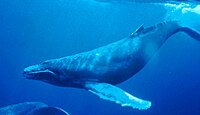
Photo from wikipedia
Humpback whales (Megaptera novaeangliae) in the western North Pacific breed in the Philippines and Japan, where there is relatively little scientific data available, leading to uncertainty about their population status… Click to show full abstract
Humpback whales (Megaptera novaeangliae) in the western North Pacific breed in the Philippines and Japan, where there is relatively little scientific data available, leading to uncertainty about their population status and structure. This study investigates links between humpback whale populations in northern Philippines and Ogasawara, Japan, through a comparison of the most recent fluke identification catalogues. The Philippines catalogue (1999–2016) included 234 individuals, and the Ogasawara catalogue (1987–2014), 1389 individuals. The number of matched individuals was 86 (including 14 known females and 40 known males), corresponding to 36.8% of the Philippines and 6.2% of the Ogasawara catalogues. The findings included four within-season matches, with travel times as short as 25 days. The results suggest that a considerable portion of whales utilising Philippine waters pass through and also utilise the Ogasawara region, but the majority of whales found off Ogasawara either stay in that location, move to different breeding grounds, or remain out of the sampling area. Nevertheless, in light of the high site fidelity of individuals in the Philippines and Ogasawara area, as well as constant evidence of breeding activities, these regions are of importance to the lesser known western North Pacific subpopulation. Humpback whales migrating to this part of the world are estimated to be in relatively low abundance, therefore continued conservation attention is needed.
Journal Title: Pacific Conservation Biology
Year Published: 2020
Link to full text (if available)
Share on Social Media: Sign Up to like & get
recommendations!